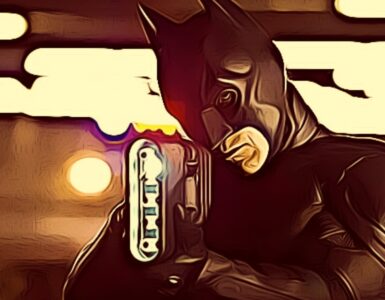Wherever Batman goes, there is sure to be an explosion or two. But believe it or not, there are times when the big bangs occur due to the Caped Crusader himself; and not from somebody else. You have to admit blowing stuff up can be cool! So in the name of curious and harmless fun, let’s take a look at major details about homemade explosives.
We will give a fair warning, though; we’re not encouraging you to go blow up somewhere important, so please resist the temptation, however strong they may be. We don’t want you getting yourself or others seriously hurt!
Furthermore, it is illegal under federal explosives law, and it is illegal to manufacture, store, distribute, receive or transport explosive materials without a federal explosives license or permit (FEL/FEP). You don’t want the feds knocking at your door during dinner.
Types of Homemade Explosives
Homemade explosives can also be called IEDs or improvised explosive devices. They are called these because they are explosive devices that are usually made in a non-industrial setting, such as a home.
They could also be called these because they are usually made from materials that anybody can easily access or materials made in the home. You can imagine a Bat-pellet made out of home components that would fit perfectly into Batman’s utility belt. That would come in quite handy.
Primarily homemade explosives are used to form a distraction of some sort and are the prelude to another type of attack. They can also disrupt or even delay opposition, giving whoever detonates them a chance to regroup or retreat. An explosive device using homemade explosives usually has five different components.
They are a switch (activator), an initiator (fuse), container (body), charge (explosive), and a power source (battery). It is a known fact that most homemade explosives operate based on blast force, but some can be made to cause injuries or wounds beyond the blast radius. In this case, the idea would be to add some sharp or projectile materials that could travel and cause harm.
Here are some categories of IEDs or homemade explosives
TIME
Homemade explosives in this class use a time switch. A time switch is simply any device that starts a timer or a countdown before it explodes. Sometime, this can be done using a simple solution, like a clock; either digital or analog. If you wanted to be more imaginative though, you could make use of two items with electrical contacts separated by something temporary, like ice. Once the ice melts, the electrical contacts will connect, and this will lead to the bomb exploding.
COMMAND
Homemade explosives of this category are handled directly by the maker of the bombs. They can be tethered, which means the bomb has a physical connection to the maker, or non-tethered, which means the bomb is remotely controlled. Tethered connections can easily be made through the use of items like fishing wires, lamp cords, or any type of string. Non-tethered connections can be made using electronic devices like cellphones and cordless phones, or even wife connections and key fobs
VICTIM-OPERATED
Victim-operated homemade explosives are usually the most common type of homemade explosives. This is perhaps because homemade explosives can be tricky to set off physically, and remote commands might not even set them off properly. Instead, victim-operated bombs are detonated by a victim that may be unsuspecting or not. Any number of means may be used to detonate a bomb of this sort, such as trigger detonation, a pressure switch, an infrared sensor, or a trip line, kind of like the ones the Joker uses in his traps. There are 3 classes of explosive materials:
Classes of Explosives
There are essentially three types or classes of explosives made from materials and chemicals. They are;
- High explosives (such as, dynamite, flash powders, and bulk salutes)
- Low explosives (such as, black powder, safety fuses, igniters, igniter cords, fuse lighters, and “display fireworks”, except for bulk salutes)
- Blasting agents (such, ammonium nitrate-fuel oil and certain water gels).
Types of Homemade Explosives and Their Uses
So, we already know that homemade explosives can be used to make big bangs (not the evolutionary kind, we’re not trying to be God here), but what else can they be used to do? Let’s take a look;
Nitroglycerine
This is a potent and extremely sensitive liquid explosive. It is usually mixed with other inert materials to form propellants, dynamites, and blasting gelatins. Nitroglycerine is particularly sensitive to heat, flame, shock, oxygen, or UV radiation and is not transported or used in its pure form as it can be too dangerous to handle.
Some types of explosives containing nitroglycerine, such as dynamite, release nitroglycerine liquid when in contact with water. Keep this in mind because it won’t be easy for firefighters to put out if anything goes wrong.
Nitroglycerine is also transported and used either as a dilute solution in alcohol or as a mixture with a solid dilutant for pharmaceutical purposes. Nitroglycerine is highly toxic in both its vapor and liquid forms and is readily absorbed through the skin.
Peroxide homemade explosives
Peroxide explosives are extremely explosive and therefore are some of the most dangerous materials ever to exist. Oftentimes, it would help if you only had only small portions to cause any serious damage, making them the most common constituents of homemade bombs. If you start from scratch kind of person, manufacturing peroxides is as easy as pie. You can find instructions on how to make them yourself online.
A typical peroxide explosive would be made up of;
- Hydrogen peroxide like hair dyes
- Acid, as seen in battery acids, brick cleaners, and citric acid used in brewing.
- Acetone, as seen in most glue removers and nail polish removers (gorilla glue girl, get in here!)
- Hexamine, which you can find mostly in camping stove fuel tablets
Peroxide explosives can take on different shapes, sizes, and textures. They can be in powder form, but they can also appear as granular textures like sugar. Whatever you do, ensure to keep these materials cool or its bye-bye boom.
Peroxide explosives have been used to make some common types of bombs.
Examples are:
- Triacetone triperoxide (TATP) is an explosive that has appeared as a terrorist weapon mostly in the Middle East. TATP has mostly been used by suicide bombers and is one of the most sensitive kinds of explosives. They are very volatile to touch, temperature and friction.
- Hexamethylene triperoxide diamine (HMTD) is another peroxide-type explosive that is less sensitive than TATP. However, it is still very dangerous.
Gunpowder/black powder/black blasting powder
These explosives are usually made from a food old-fashioned mixture of charcoal, potassium nitrate, and Sulphur. They are the type you refer to as low explosives. They can be very sensitive to detonation from heat, friction, and sparks.
They can burn with a fiery rage, and if you try to contain them, you are prone to explosions. One major feature about them is the smoke they exude whenever they start to burn. They have been used in common items like sporting cartridges and fireworks.
You could find any of these materials in the most common places. Remember that making homemade explosives for yourself is highly illegal. You could get you in trouble with the law, or worse, seriously hurt.























